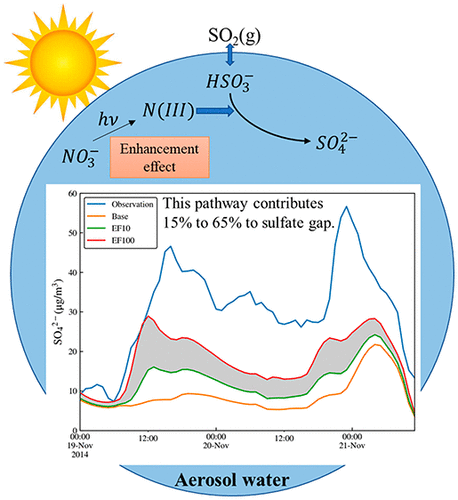当前位置:
X-MOL 学术
›
Environ. Sci. Technol. Lett.
›
论文详情
Our official English website, www.x-mol.net, welcomes your
feedback! (Note: you will need to create a separate account there.)
Contribution of Particulate Nitrate Photolysis to Heterogeneous Sulfate Formation for Winter Haze in China
Environmental Science & Technology Letters ( IF 8.9 ) Pub Date : 2020-06-25 , DOI: 10.1021/acs.estlett.0c00368 Haotian Zheng 1, 2, 3 , Shaojie Song 3 , Golam Sarwar 4 , Masao Gen 5 , Shuxiao Wang 1, 2, 3 , Dian Ding 1, 2 , Xing Chang 1, 2 , Shuping Zhang 1 , Jia Xing 1, 2 , Yele Sun 6 , Dongsheng Ji 7 , Chak K Chan 8 , Jian Gao 9 , Michael B McElroy 3
Environmental Science & Technology Letters ( IF 8.9 ) Pub Date : 2020-06-25 , DOI: 10.1021/acs.estlett.0c00368 Haotian Zheng 1, 2, 3 , Shaojie Song 3 , Golam Sarwar 4 , Masao Gen 5 , Shuxiao Wang 1, 2, 3 , Dian Ding 1, 2 , Xing Chang 1, 2 , Shuping Zhang 1 , Jia Xing 1, 2 , Yele Sun 6 , Dongsheng Ji 7 , Chak K Chan 8 , Jian Gao 9 , Michael B McElroy 3
Affiliation

|
Nitrate and sulfate are two key components of airborne particulate matter (PM). While multiple formation mechanisms have been proposed for sulfate, current air quality models commonly underestimate its concentrations and mass fractions during northern China winter haze events. On the other hand, current models usually overestimate the mass fractions of nitrate. Very recently, laboratory studies have proposed that nitrous acid (N(III)) produced by particulate nitrate photolysis can oxidize sulfur dioxide to produce sulfate. Here, for the first time, we parametrize this heterogeneous mechanism into a state-of-the-art Community Multiscale Air Quality (CMAQ) model and quantify its contributions to sulfate formation. We find that the significance of this mechanism mainly depends on the enhancement effects (by 1–3 orders of magnitude as suggested by the available experimental studies) of the nitrate photolysis rate constant (JNO3–) in aerosol liquid water compared to that in the gas phase. Comparisons between model simulations and in situ observations in Beijing suggest that this pathway can explain from about 15% (assuming an enhancement factor (EF) of 10) to 65% (assuming EF = 100) of the model–observation gaps in sulfate concentrations during winter haze. Our study strongly calls for future research on reducing the uncertainty in EF.
更新日期:2020-06-25











































 京公网安备 11010802027423号
京公网安备 11010802027423号